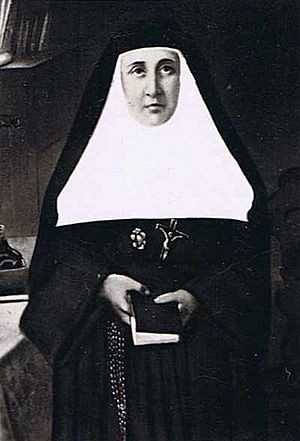María Rafols Bruna facts for kids
Quick facts for kids BlessedMaría Rafols Bruna |
|
|---|---|

Devotional print c. 1880.
|
|
| Religious and Foundress | |
| Born | 5 November 1781 Vilafranca del Penedès, Barcelona, Kingdom of Spain |
| Died | 30 August 1853 (aged 71) Zaragoza, Kingdom of Spain |
| Venerated in | Roman Catholic Church |
| Beatified | 16 October 1994, Saint Peter's Square, Vatican City by Pope John Paul II |
| Feast | 30 August |
| Attributes | Religious habit |
| Patronage |
|
María Rafols Bruna (born November 5, 1781 – died August 30, 1853) was a Spanish Catholic nun. She was also a mystic and helped start a group called the Sisters of Charity of Saint Anne. She founded this group with a Catholic priest named Juan Bonal Cortada.
María Rafols spent her life helping sick people in hospitals in Zaragoza. She even risked her life to help others during wars. She held different leadership roles in her group, sometimes stepping down due to challenges. She was also captured during a war, but later set free.
After she died, many people thought of María Rafols as a saint. Her journey to becoming a saint began in 1931. Pope John Paul II declared her "Venerable" in 1991 and "Blessed" in 1994. This special ceremony took place in Saint Peter's Square in Vatican City.
Contents
Early Life and Family
María Rafols Bruna was born in Barcelona, Spain, on November 5, 1781. She was the sixth of ten children in her family. Her parents were Cristóbal Rafols Cunillera and Margarita Bruna Brugol. Her father worked as a miller.
In May 1783, María and her family moved to a place called La Bleda. On May 27, 1785, she received her Confirmation. This is an important sacrament in the Catholic Church. She completed her schooling at a boarding school in Barcelona.
In 1792, she moved again, this time to Santa Margherita. Sadly, her younger brother Juan died there in 1793. Five of her siblings also died when they were children. Her two uncles passed away between 1793 and 1794. Her father died on July 10, 1794.
Starting a New Order
María Rafols later joined a group of twelve women. They were led by Juan Bonal Cortada. This group worked in a small hospital in Zaragoza. They arrived at the hospital of Nuestra Señora de Gracia in December 1804.
The group helped abandoned children, people with disabilities, and those with mental health conditions. María helped Cortada turn this small group into a religious order. They officially founded the order together on December 28, 1804. In 1806, María became the Mother Superior, which is like a leader. This role sometimes caused disagreements with other hospital workers.
Helping During Wars
During the Napoleonic Wars, María worked in bombed buildings. She bravely saved children and cared for the sick. On August 4, 1808, the hospital where the sisters worked was bombed. The group had to find safety elsewhere.
The French army left on August 14, 1808. But they started another attack on December 10, 1808. María even went into the French army camp. She asked General Jean Lannes to help care for the sick and wounded.
María stepped down as the hospital's board president on November 12, 1811. She then traveled to Orcajo in Daroca. She became superior again on August 10, 1812, after new rules for the order were made. But she had to resign again due to internal problems. She was later appointed superior once more, serving from 1826 to 1829.
On July 16, 1825, María Rafols and other women made their vows to join the order.
Challenges and Later Life
During the Carlist War, María was arrested on May 11, 1834. She was accused of acting against Queen Isabel II of Spain. She was imprisoned and sent away to Huesca. After some time in prison, she was released on May 11, 1835.
María Rafols was allowed to return to Zaragoza in 1841. She had been living away from her hometown since her release. In 1845, she asked to retire. However, she still continued to work for the order.
The religious order received official approval from Pope Leo XIII on January 14, 1898. Their rules were first approved in 1883. Then, Pope Pius X gave them full papal approval on March 11, 1904.
Becoming Blessed
The process to declare María Rafols "Blessed" began in Zaragoza. This investigation started on July 1, 1926, and finished on January 28, 1927. Experts then checked her writings to make sure her spiritual ideas were correct. They approved her writings on March 30, 1931.
The official start of her cause happened on August 6, 1931. Pope Pius XI gave her the title of Servant of God.
The process was paused for a while in 1944. But Pope John Paul II allowed it to continue in 1980. In 1989, a special report was sent to the Congregation for the Causes of Saints. This group approved the report on July 6, 1991. On the same day, John Paul II declared her Venerable. This meant he confirmed that María Rafols had lived a life of great goodness.
For someone to be declared "Blessed," a miracle is usually needed. A healing that happened was investigated. Doctors confirmed it was a miracle on February 12, 1993. Theologians and cardinals also agreed. Finally, Pope John Paul II gave his approval on July 6, 1993. He then declared Mother María Rafols "Blessed" in Saint Peter's Square on October 16, 1994.
See also
 In Spanish: María Rafols Bruna para niños
In Spanish: María Rafols Bruna para niños

